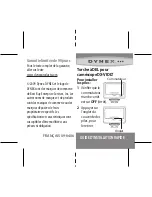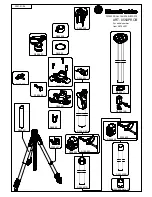
INTRODUCTION
8
Battery Pack to be Used
The GY-HD250/GY-HD251 can use any of the following bat-
teries. (Factory setting)
U model: Anton Bauer battery
E model: IDX battery
Recommended batteries
U model: Dionic 90 (Anton Bauer)
E model: Endura-7 (IDX)
CAUTION
Use only the recommended batteries.
If a heavy battery is used, the battery may fall out depend-
ing on the way the HD camera recorder is used.
Videocassette to be Used
• Use JVC’s videocassette tapes marked with the
A
symbol.
• Mini DV videocassette
: M-DV63HD
M-DV63PROHD
* Do not use M-DV80.
• Videocassettes cannot be used upside down.
• Avoid storing a videocassette with its tape not being com-
pletely wound, as this may damage the tape. Rewind it to
the beginning before placing a cassette into storage.
• Store videocassettes in a place with little humidity and
good ventilation where mould does not form.
• After a videocassette tape has been used repeatedly, it
becomes unable to maintain full performance due to an
increase in noise caused by dropouts, etc. Do not continue
to use a dirty or damaged tape, as this will reduce the
rotary head life.
• Videocassette tapes with the
A
symbol are provided
with a switch on the back to prevent accidental erasure.
• Slide the switch to SAVE to protect the required recording
in the tape from being overwritten.
• To record on the tape, slide the switch to REC.
For recording and storing
videotapes in the best con-
dition
Observe the following instructions for the best recording and
storage of videotapes.
• Take care of the conditions of handling videotapes. It is
recommended that you record and store videotapes in the
environment below.
• Do not leave the videotapes neglected for a long period. If
videotapes are left wound for a long period of time, it may
result in distortion of the tape. Also it may cause tape-to-
tape adhesion (known as blocking). It is recommended
that videotapes be unspooled and rewound once a year
for refreshing.
• When tapes are not in use, store them in cases and on
end. Storage cases protect videotapes from humidity, dust
and ultraviolet light. Keep tapes in cases and do not store
them lying flat. When housed in a horizontal position, pres-
sure from other tapes can cause distortions and deforma-
tions of the tape edges.
Switch
Recording
Storage
Short period
(Up to 10
years)
Long period
(Over 10
years)
Temperature
17°C to 25°C 15°C to 23°C 15°C to 19°C
Humidity
30% to 70%
40% to 55%
25% to 35%
Hourly tempera-
ture change
Less than
10°C
H
H
Hourly humidity
change
Less than
10%
H
H
9
Condensation
• If this device has been cooled down in a cold place and is
then carried to a warm place, the moisture contained in
the warm air may adhere to the head drum or tape guides
and be cooled into water droplets. This phenomenon is
referred to as condensation (dew). When this occurs, the
head drum and tape guides are covered with droplets
allowing the tape to be stuck to them, leading to tape dam-
age.
• Condensation occurs in the following cases:
• When this device is suddenly
moved from a cold place to a
warm place.
• When a room heater has just
started or when this device is
exposed directly to cold air from
an air conditioner.
• When this device is placed in a
very humid place.
• “CONDENSATION ON DRUM” is displayed on the LCD
monitor and in the viewfinder when condensation occurs
in this device.
Keep the power on until the warning message disappears.
• Pay attention to condensation even before the condensa-
tion indication appears.
As condensation forms gradually, the condensation indica-
tion may not appear for the first 10-15 minutes after con-
densation has formed inside.
In an extremely cold place, the condensation could freeze
and turn into frost. In such a case, it takes an additional 2-
3 hours for the frost to first melt into condensation and
then to be dissolved.
• To prevent condensation
When moving this device from one place to another where
the temperatures are greatly deferent, first remove the vid-
eocassette, place this device in a tightly sealed vinyl bag,
and then move it to a new environment.
To ensure no condensation occurs, allow the temperature
of this device in the bag to reach that of the new environ-
ment before using it.
Characteristic CCD Phe-
nomena
Smear and Blooming
Due to the physical structure of a CCD it is possible to induce
vertical streaking (called “smear”) when shooting an
extremely bright light source. Another effect is the expansion
of light around a bright light or object (called “blooming”).
The CCD employed in this device is characterized by induc-
ing very little smear or blooming. Nevertheless, please take
note that smear or blooming may be induced when shooting
a bright light source.
Moire or Aliasing
Shooting stripes or fine patterns may cause a jagged effect
or a banding in fine mesh patterns.
White dots
High temperatures can cause CCD sensor pixels to produce
the effect of white dots in the image. This condition is con-
spicuous especially when gain is applied.
This is a characteristic of the charged-coupled device (CCD).
As far as possible, use this device under conditions where
the temperature of this device does not increase.
Do not leave the videocassette inserted when moving the
camera under conditions where the temperature environ-
ment changes.
After moving this device, do not use until the internal parts
have stabilized.
Head drum
Video tape
Smear
Vertical pale streaking appearing at high
luminous object
High luminous object
(Electric light, sunlight, etc.)
Blooming
Blurring in highlight
Monitor screen
















































